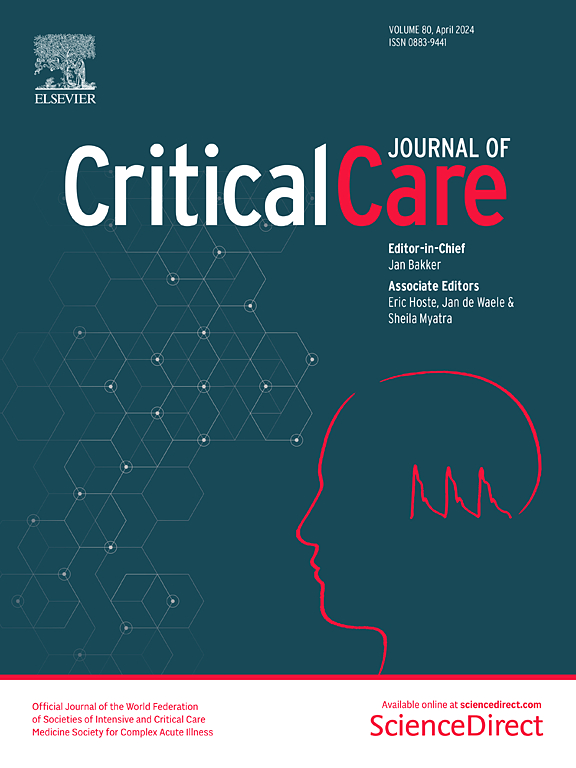Detection of hypovolemia by non-invasive hemodynamic monitoring during major surgery using Ringer´s solution, 5% albumin, or 20% albumin as infusion fluid: a post-hoc analysis of a randomized clinical trial
IF 8.8
1区 医学
Q1 CRITICAL CARE MEDICINE
引用次数: 0
Abstract
Fluid loading with crystalloids is the conventional treatment of major hemorrhage but might tend to create fluid overload. We studied hemodynamic profiles of fluid replacement therapies during major surgical hemorrhage and compared the ability of pulse pressure variation (PPV), plethysmographic variation index (PVI), cardiac output (CO) and Guyton´s approach to detect hypovolemia. In this single center randomized controlled trial, fluid replacement therapy to treat hemorrhage in 42 patients was randomized to consist of either 5% albumin (12 mL/kg) or 20% albumin (3 mL/kg) over 30 min, both completed by Ringer lactate replacing blood loss in a 1:1 ratio, or Ringer solution alone in a 3:1 ratio. Measurements included CO, PPV, PVI, arterial and central venous pressures, heart rate (HR) and subsequent calculation of Guyton´s physiological parameters. CO was measured by an esophageal Doppler probe. The Ringer-only fluid program resulted in slight hypovolemia (mean, 313 mL), decreased mean arterial pressure (MAP), increased HR, PPV values and vasopressor requirement. The 5% and 20% albumin programs were more effective in filling the vascular system, as evidenced by higher mean circulatory filling pressure and unchanged or decreased PPV over the 5 h observation period. The 20% albumin increased the systemic vascular resistance and the resistance to venous return. Receiver operating characteristics curves indicated that hypovolemia > 500 mL could only be accurately detected by PPV when 5% albumin was used, that PVI was reliable when Ringer was infused, and that CO indicated the hypovolemia when 20% albumin was administered. The trends in PPV, PVI, and CO reflected the changes in intravascular volume, but how well they indicated hypovolemia > 500 mL may differ depending on the choice of infusion fluid. Identifying hypovolemia using non-invasive hemodynamic monitors remains challenging and associated with low predictive values. Trial registration number: NCT05391607, May 26, 2022.使用林格氏液、5% 白蛋白或 20% 白蛋白作为输注液,通过无创血液动力学监测检测大手术过程中的低血容量:随机临床试验的事后分析
用晶体填充液体是大出血的常规治疗方法,但可能会造成液体过载。我们研究了外科大出血期间液体替代疗法的血流动力学特征,并比较了脉压变化(PPV)、体积变化指数(PVI)、心输出量(CO)和Guyton方法检测低血容量的能力。在这项单中心随机对照试验中,42例患者的出血液体替代疗法被随机分为5%白蛋白(12 mL/kg)或20%白蛋白(3 mL/kg) 30分钟,均由1:1比例的乳酸林格液替代失血量或3:1比例的林格液单独完成。测量包括CO, PPV, PVI,动脉和中心静脉压,心率(HR)和随后计算Guyton的生理参数。用食管多普勒探头测量CO。仅林格液体方案导致轻度低血容量(平均313 mL),降低平均动脉压(MAP),增加HR, PPV值和血管加压药需求。5%和20%的白蛋白方案更有效地填充血管系统,在5小时的观察期间,平均循环填充压力更高,PPV不变或降低。20%的白蛋白增加了全身血管阻力和静脉回流阻力。受试者工作特征曲线显示,低血容量> 500 mL只有在5%白蛋白时才能被PPV准确检测到,当Ringer输注时,PVI是可靠的,当20%白蛋白输注时,CO表示低血容量。PPV、PVI和CO的变化趋势反映了血管内容量的变化,但它们在多大程度上显示低血容量(500ml)可能因输注液体的选择而异。使用无创血流动力学监测仪识别低血容量仍然具有挑战性,且预测值较低。试验注册号:NCT05391607, 2022年5月26日。
本文章由计算机程序翻译,如有差异,请以英文原文为准。
求助全文
约1分钟内获得全文
求助全文
来源期刊

Critical Care
医学-危重病医学
CiteScore
20.60
自引率
3.30%
发文量
348
审稿时长
1.5 months
期刊介绍:
Critical Care is an esteemed international medical journal that undergoes a rigorous peer-review process to maintain its high quality standards. Its primary objective is to enhance the healthcare services offered to critically ill patients. To achieve this, the journal focuses on gathering, exchanging, disseminating, and endorsing evidence-based information that is highly relevant to intensivists. By doing so, Critical Care seeks to provide a thorough and inclusive examination of the intensive care field.
 求助内容:
求助内容: 应助结果提醒方式:
应助结果提醒方式:


